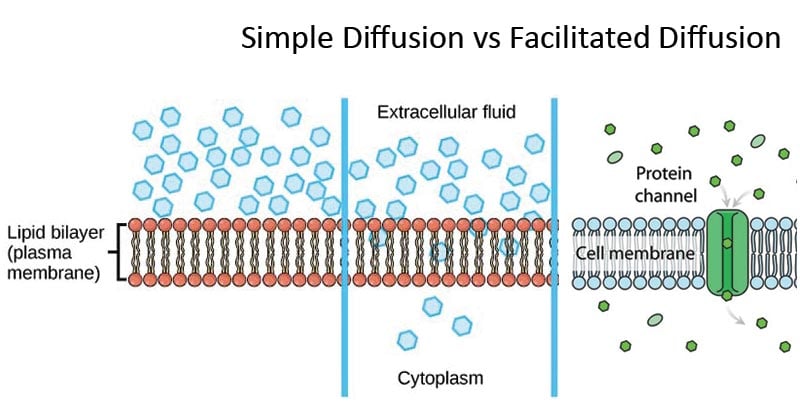
Image Source: Khan Academy and Wikipedia
Interesting Science Videos
Some of the differences are as follows:
| Characteristics | Simple Diffusion | Facilitated Diffusion |
| Definition | Simple diffusion is a type of passive transport which, as the name suggests, is simply the unassisted movement of solute which occurs when its electrochemical potentials on the two sides of a permeable barrier are different. | Facilitated diffusion is the process of biological transport in which specific structural components of biological membranes interact with particular solutes or classes of solutes, markedly increasing the rates at which they can cross the membrane. |
| Driving Force | The driving force for simple diffusion is the concentration gradient across the membrane. | The difference in concentration of solute across the membrane is the driving force for facilitated diffusion |
| Energy requirement | Simple diffusion is a passive transport as thus, doesn’t require any energy. | Facilitated diffusion is also a passive transport mechanism that doesn’t require any energy, but some facilitated diffusion processes can be active. |
| Speed | The speed of simple diffusion is relatively low. | The speed of facilitated diffusion is relatively higher. |
| Solute specificity | The process of simple diffusion is not solute specific. | Facilitated diffusion is directed by the specificity between solute and carrier molecules. |
| Additional forces | Besides the concentration gradient, the kinetic energy of the molecules also drives the process of simple diffusion. | As in simple diffusion, the process is driven by kinetic energy in addition to the concentration gradient. |
| Inhibition | Simple diffusion is not inhibited by an inhibitor molecule. | Facilitated diffusion can be inhibited by specific inhibitor molecules. |
| Direction of movement | In simple diffusion, the movement of particles occurs along the direction of the concentration gradient. | In facilitated diffusion, the movement of molecules can occur both in direction and opposite of the concentration gradient. |
| Size of molecules | Simple diffusion is mostly involved in the passage of small non-polar molecules. | Facilitated diffusion is commonly involved in the movement of large and polar molecules across a biological membrane. |
| Channel proteins | In simple diffusion, the movement of molecules occurs either through the general surface of the membrane | Certain channel proteins are involved in facilitated diffusion, which results in the formation of particular pores for the movement of molecules. |
| Examples | The exchange of gases between lungs and blood, the mixing of gases in the atmosphere, and the absorption of nutrients by bacteria are some examples of simple diffusion. | Transfer of ions like calcium and potassium, movement of oxygen in the blood with the help of hemoglobin, and the transport of amino acids and glucose from the blood to the cell are some examples of facilitated diffusion. |
References and Sources
- 7% – https://microbenotes.com
- 4% – https://www.thoughtco.com/diffusion-and-passive-transport-373399
- 4% – https://www.easybiologyclass.com/difference-between-simple-diffusion-and-facilitated-diffusion-a-comparison-table/
- 2% – https://en.m.wikipedia.org/wiki/Membrane_transport_protein
- 1% – https://www.biologyonline.com/dictionary/facilitated-diffusion
- 1% – https://quizlet.com/92068105/ap-physio-ex-flash-cards/
- 1% – https://quizlet.com/15699694/chapter-14-review-flash-cards/
- 1% – https://brainly.com/question/1382789
